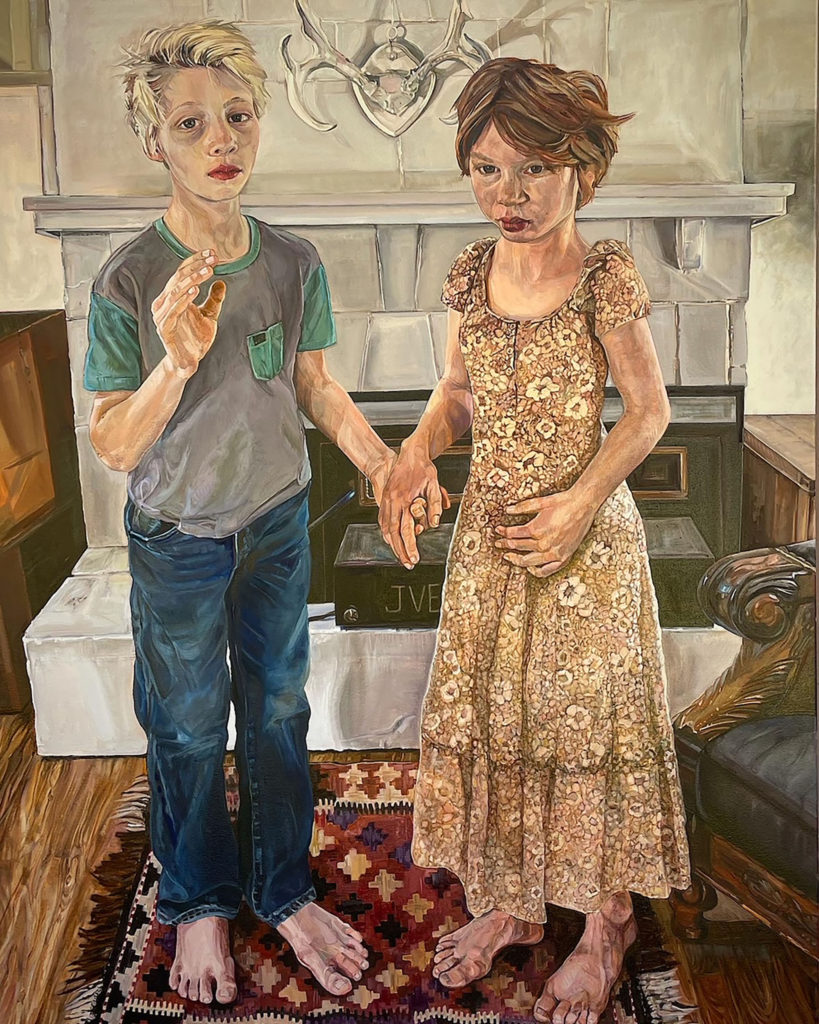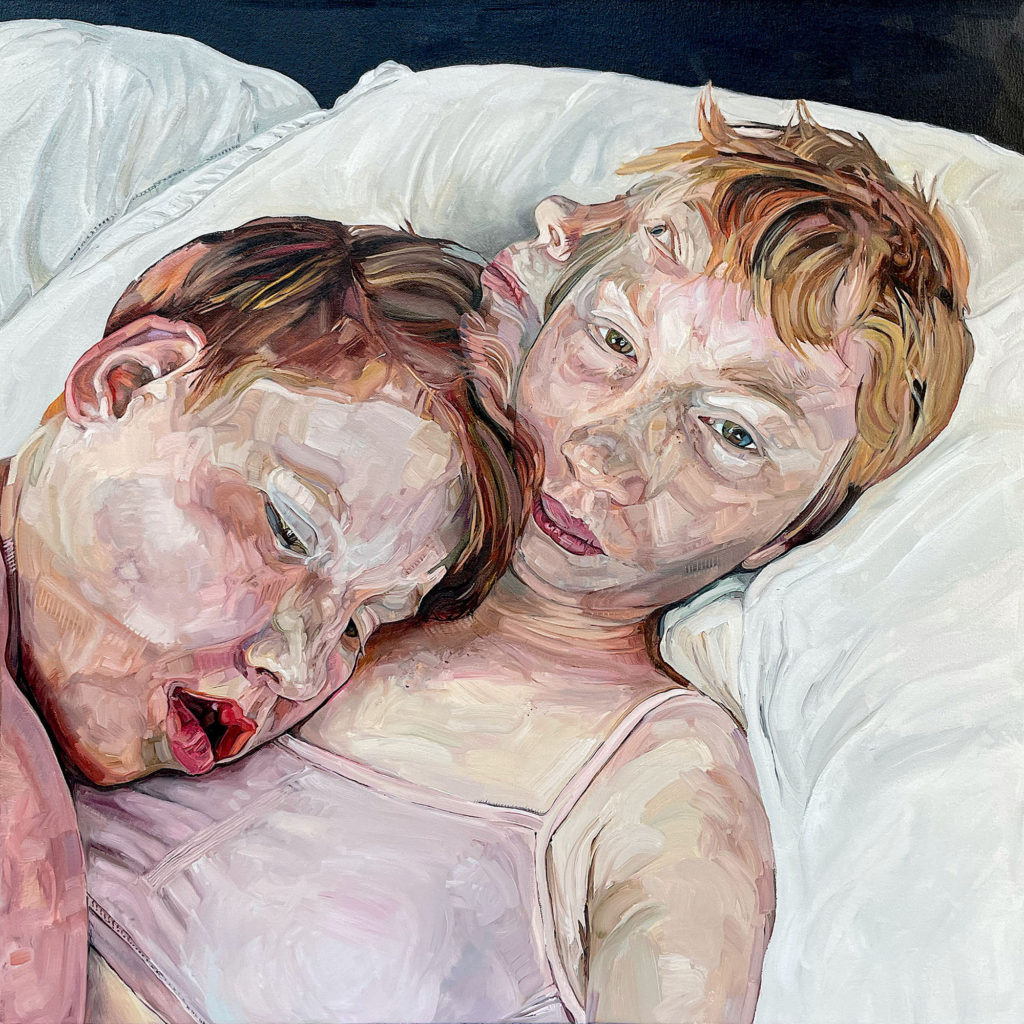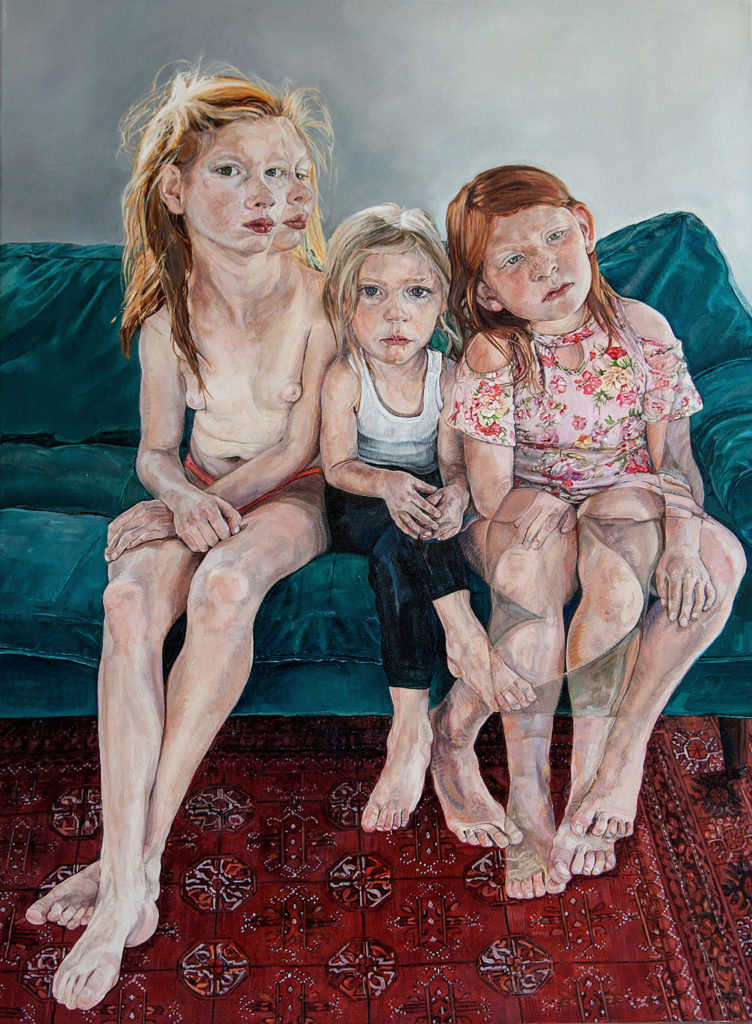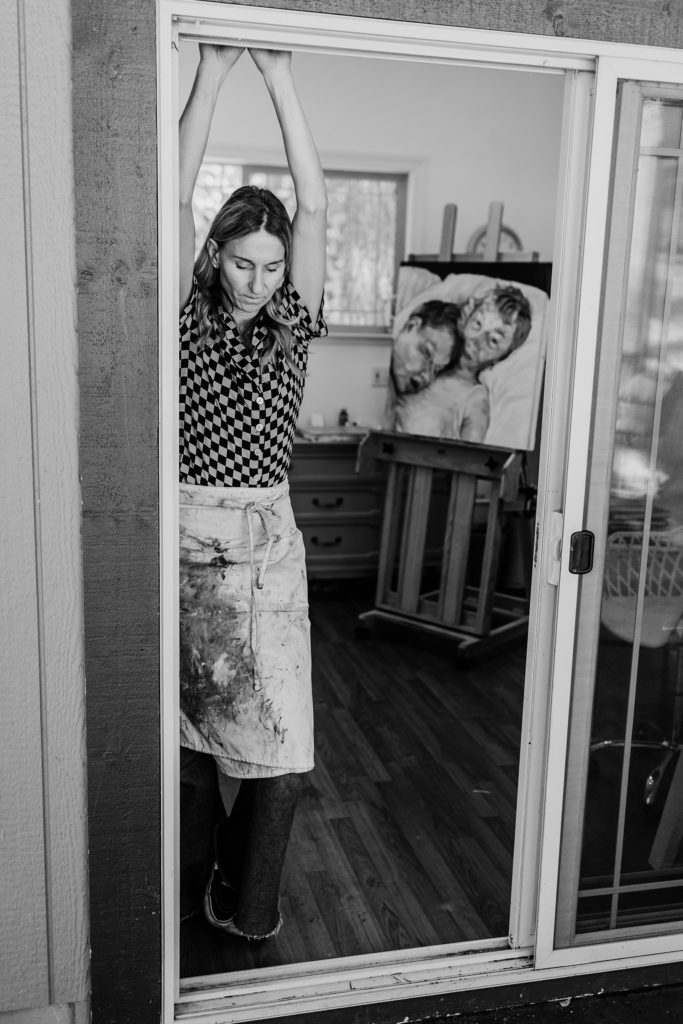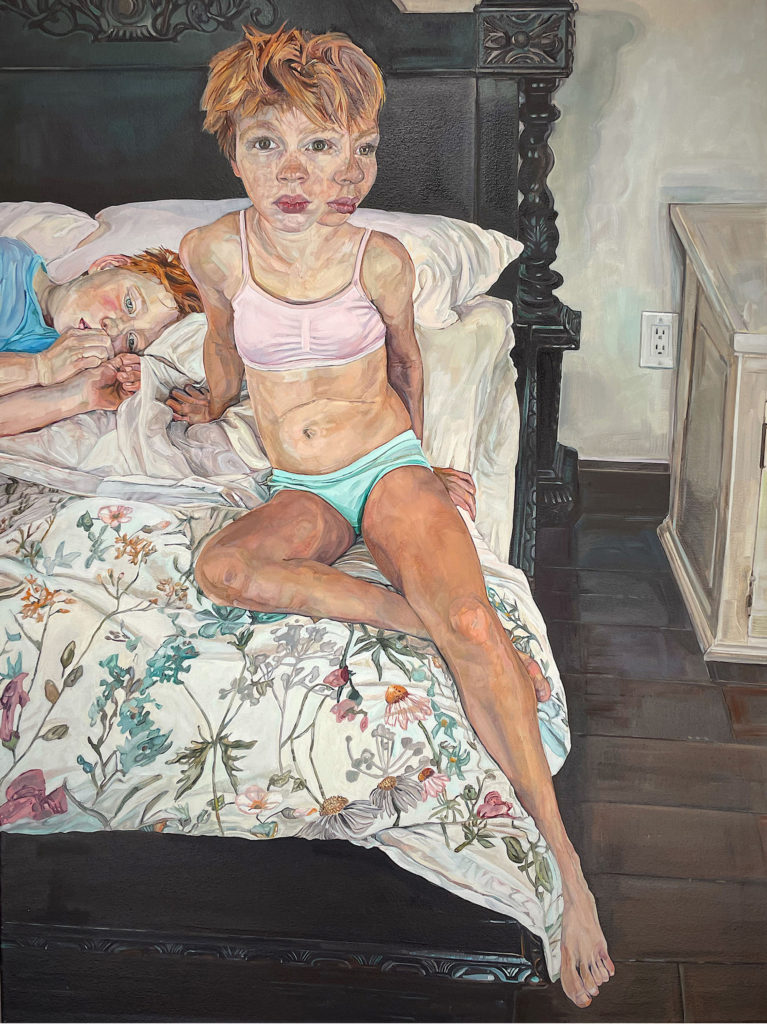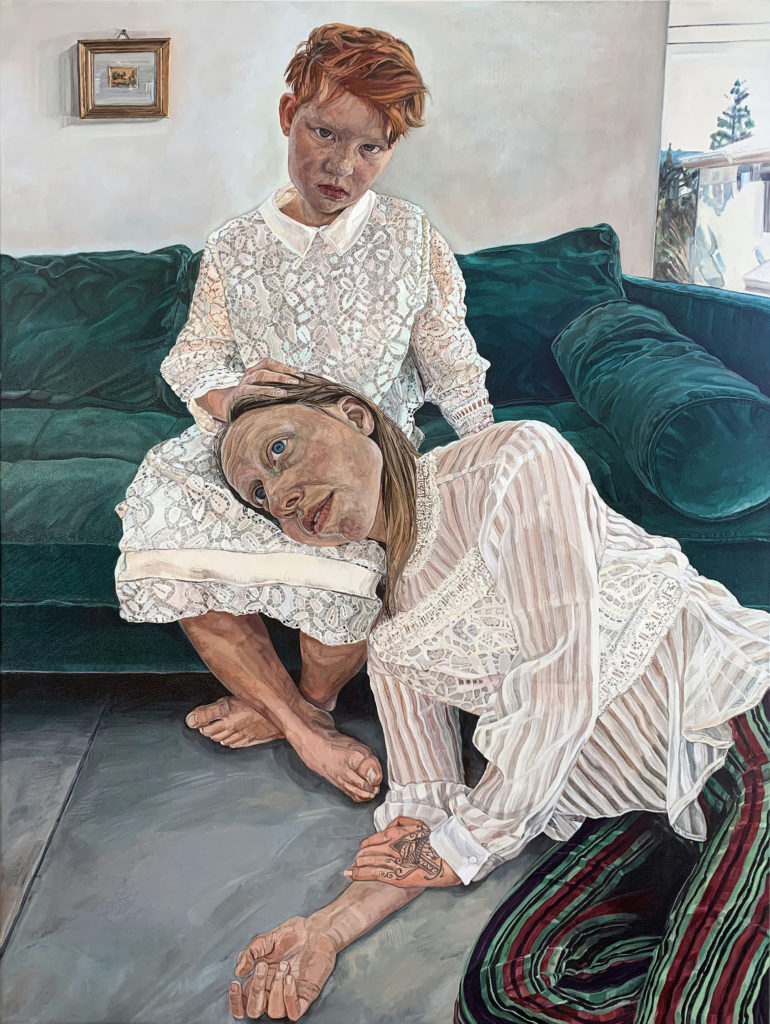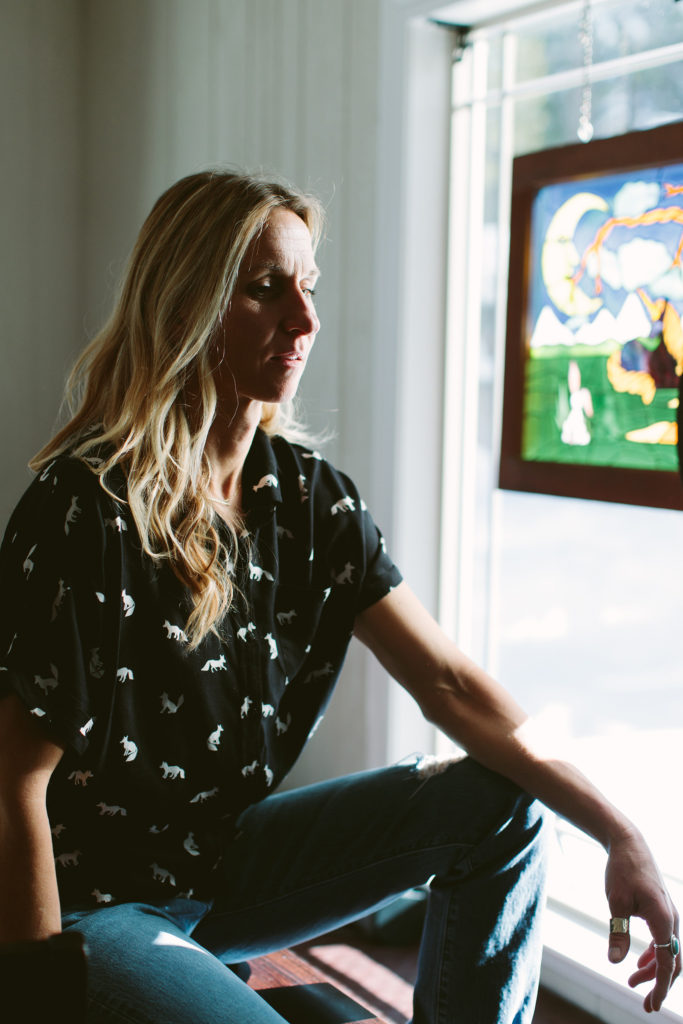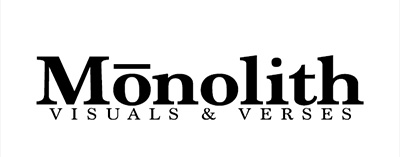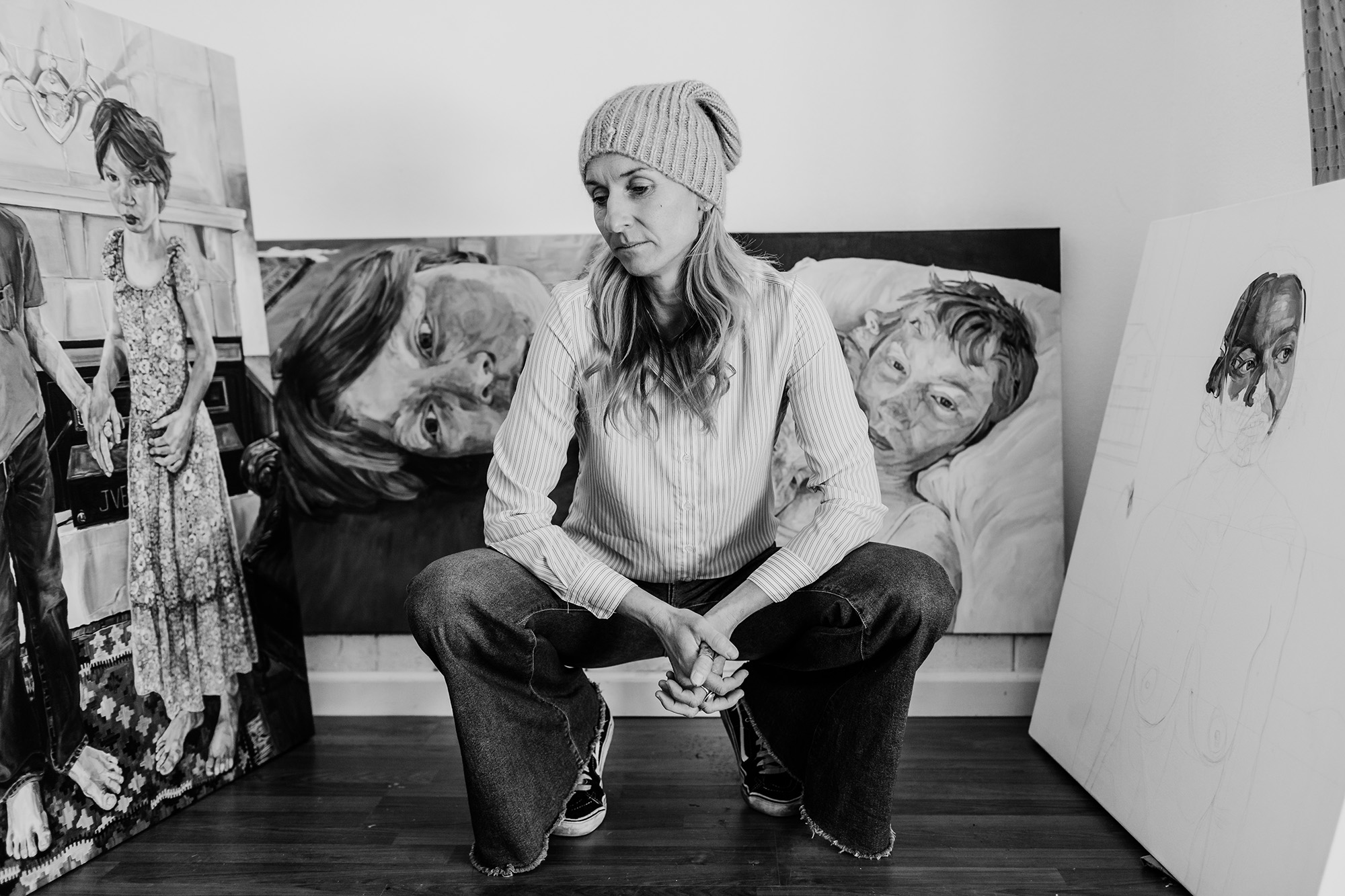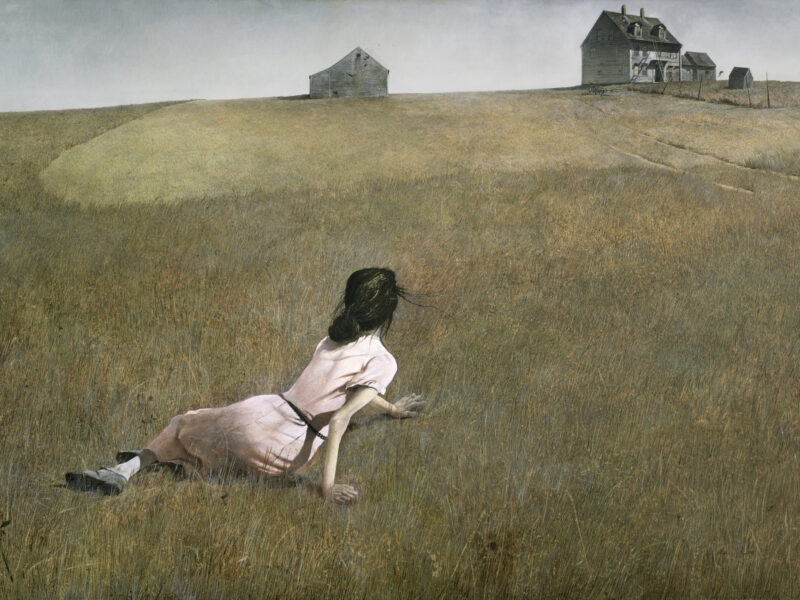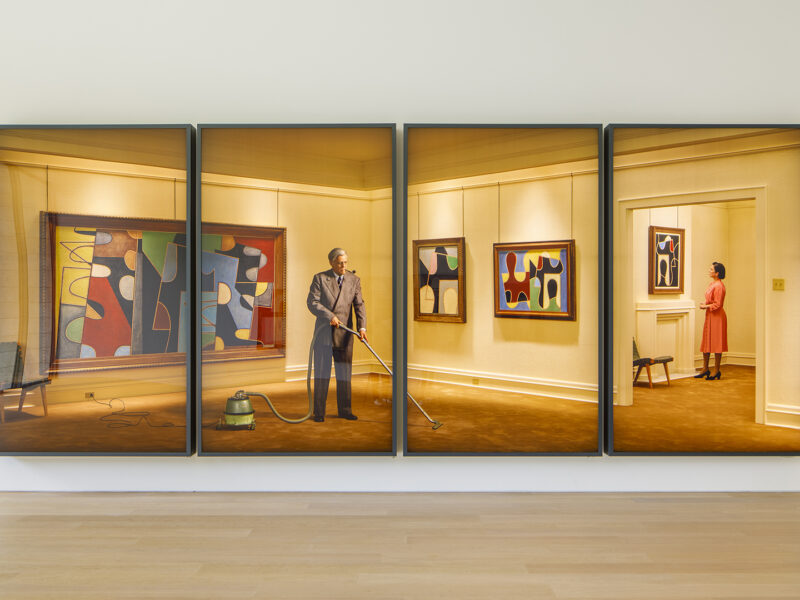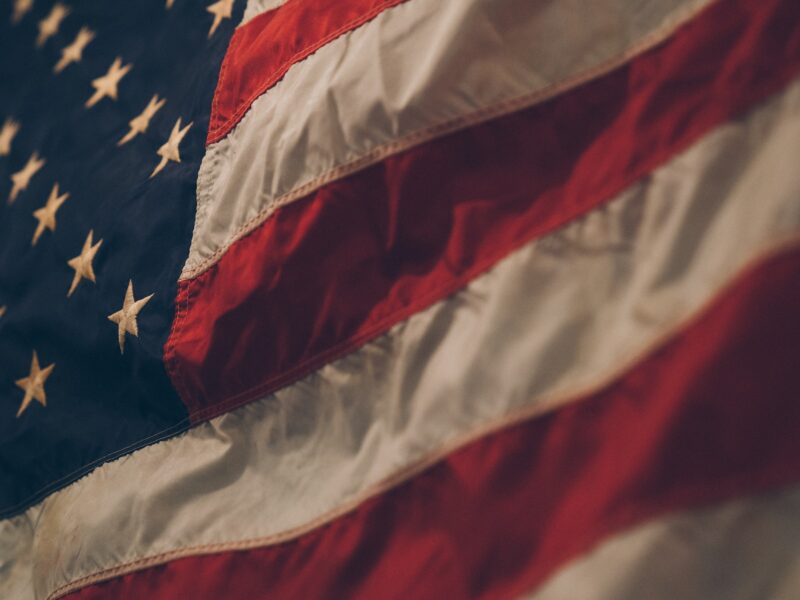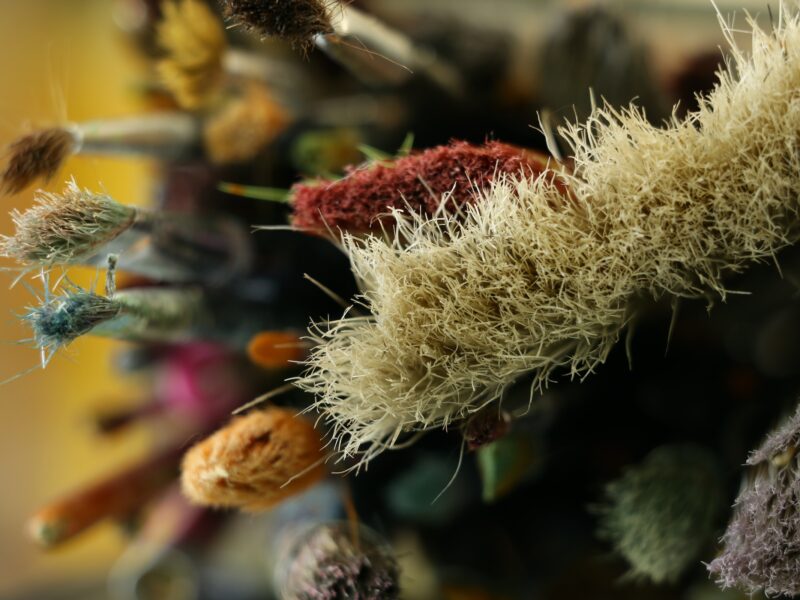Ali Warren’s work is inspired by the Flemish painters of the 15th century. Volumetric renditions of the figure set against the background of everyday life is emulated in the portrayal of her children. Our contributor Josef Goetz caught up with Ali over the Christmas holidays for an in-depth chat about her artistic process, recurring symbology and future plans. Lean back and enjoy this exclusive MV interview.
Hello Ali, forgive me but I must immediately start with the thing that struck me the most as soon as I discovered your paintings: the gigantism of the extremities and the representation of the double. Take your time, but please give me at least a hint to fully understand its intent.
I would have to say that my distortions come from a need to express the emotion I feel towards my subjects. I mostly paint my daughters and their close friends and my nephew. I feel the need to enlarge certain areas of their bodies to balance the vulnerability that I know they feel being the subject of my paintings and thus my scrutiny. It’s my way of depersonalizing them as I worry about the impact the painting will have on their view of them selves. I want to expose them but not exploit them. I want to show their beauty in the way they interact with each other and in the way their bodies take up space in this world. One of my favorite artists is Sally Mann and she was criticized for her depiction of her children at play in the nude. But I love her work. It’s very honest. And loving. And yet I relate to her trepidation about exposing her children and their nakedness to the world. The double faces are usually reserved for my daughter Tatum. She is my oldest and she was very sick most of her childhood. She received a Liver Transplant at the age of four. I paint her as impermanent because of my pain around her dance with death for most of her life.
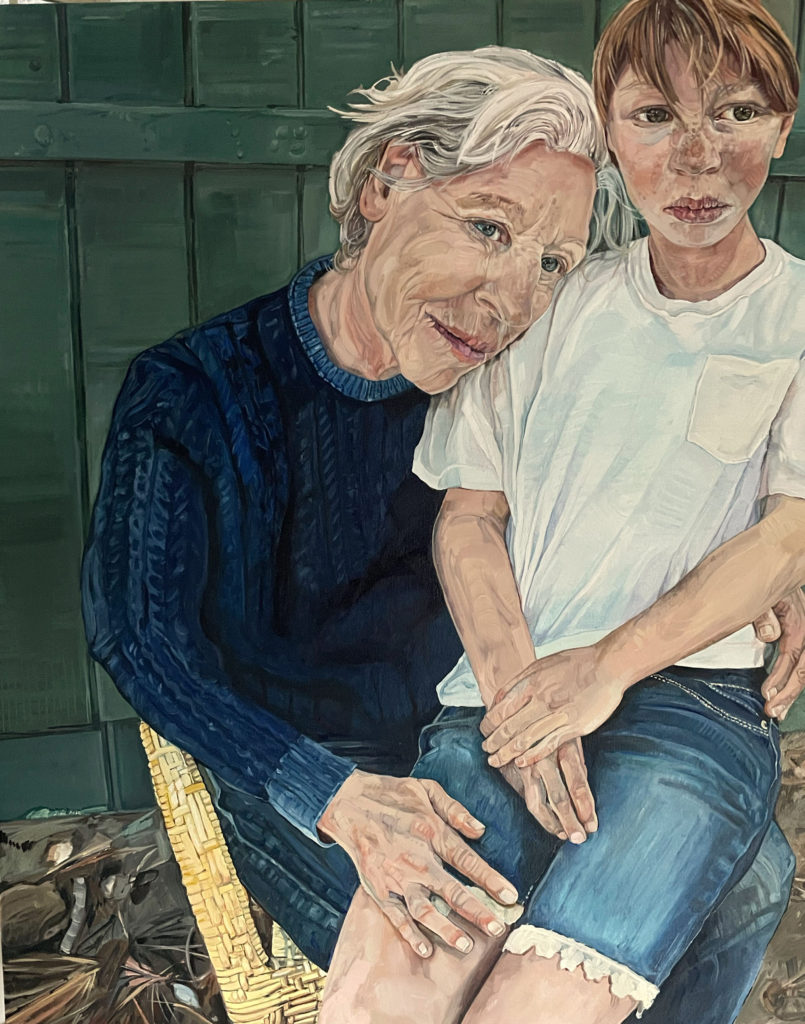 “The Tutor”. 30 x 24 inches. Oil on canvas
“The Tutor”. 30 x 24 inches. Oil on canvas
The figures all look extraordinarily familiar to you, almost a genealogical album. Are you so close to your subjects or is it just my impression?
You are not wrong in this impression. Most of my paintings are of my two children. The other children in my works are my very dear friends’ kids. They are people I spend a lot of my life with. Occasionally I will meet someone that I don’t know and will ask them to model for me but mostly it is my loved ones that let me pose them and dress them and put them in certain lighting. I use these photo references obsessively to create my compositions.
Yet I was just as impressed with your paintings as I was at the first viewing of Paul Thomas Anderson’s “There Will Be Blood”. A nascent, constructive, exemplary America for the youngest, and tremendously ferocious among adults. The portraits of your teenagers shook that feeling in me, like their eyes were mirrors of our actions. Do you find yourself in this interpretation?
I love this interpretation. That movie, in particular, is very emotional and passionate. There is a vulnerability in the protagonist that might be reflected in my models faces?One of my favorite artists is Andrew Wyeth. I feel that you are referencing an American aesthetic that was very much reflected in his work. I hope that mine conveys a real life drama set in the rooms of my home that shows a “day in the life” of my children. I hope they portray the intrepid boldness of Daniel Day Lewis although he is a tough act to follow.
“JVE” 36 x 48 inches. Oil on canvas
Coming to the technical part, I find your sublime, decisive and “nascent” trait tremendously expressive. Would you like to tell me something about your pictorial training? Where and how does it develop, and which teachers did you initially have?
Regarding the nascency of my work: it may be the insecurity I feel at being an “emerging artist”. I battle trusting myself and my voice. I would say I’m mostly self taught. But I did have a very special female teacher and landscape artist, Phyllis Shafer, who believed in me early on. She compared a very badly painted self portrait of mine to Lucian Freud. I immediately went home and looked this artist up and was completely mystified and in love with his work. Gazing upon Lucian’s bold nudes gave me courage as a young artist.
“Ode to Saville”. 30 x 30 inches. Oil on canvas
Before reading the title “Ode to Saville”, I immediately found classic stylistic features of Jenny Saville In some poses, double lines and in some grimaces of the mouths. Did you find out how she influenced you the most? Is it something you can process or is it such an intimate influence that you can’t rationalize?
Oh, I can rationalize it! Jenny Saville is the single most respectable artist of all time in my book. Her mad talent mixed with unending hard work shows in her genius. She is always pushing her limits by working large and diverse and brutally honest. One word: FLESH. But one thing I’ve come to really appreciate about Jenny is that she demands respect as a female artist and has never used her looks or sexuality to gain noterietay. I’m in awe of her.
“Juvenescence” 30 x 40 inches. Oil on canvas
I also found your color palette very interesting, always very warm and enveloping, in perfect contrast with the cold and “wearily liberty” background. Can you tell me more about your use of color?
Hhhhhmmmm, my use of color. I guess I should start with my palette. I use a variety of colors out of the tubes. I’m very sensitive to premixed colors and their cool undertones or warm gumption. That said, I’m always trying new colors. And then I use my intuition to mix them. I make some glops of base colors for my flesh tones: for example yellow ochre mixed with rose madder. I do a lot of dipping into color with my brush as I go. I try to “feel” the shadows and pull colors based on their coolness or warmth. I think a lot of Vermeer when I’m trying to capture light through warm or cool values. He inspires me when I am trying to gauge and create the light in a setting. There was no one better at painting light in a room.
Throw me for a moment in your production process. How do you usually start? Do you basically draw your sketches on paper or do you start from somewhere else?
Many times an idea will hit me while looking at pieces I love from art history. I then try to recreate this emotion through my own interpretation. For instance, “Jonah Loves Watteau” was my recreation of Lucian Freud’s “Large Interior W 11 (After Watteau)”. I knew I needed 4 figures to create the scene so I had my children and my close friend’s two children pose for me. I then took many photos of them in different outfits and patterns of clothing I knew would create interest in the painting. Their poses were very important. Although understandably controversial, the way Balthus captured childhood postures really intrigues me. I specifically had my youngest model lay in a “crouched on the ground while coloring” pose. This pose is one that Balthus uses again and again in his work. I spend a lot of time thinking and mulling things over in my mind and I do not draw my vision until it is being drawn onto the canvas. I sometimes have to erase the pencil and re-draw proportions but I do not use a sketch book to practice beforehand. As I paint I will alter the lines of the drawing to make a better execution. I’m kind of an all or nothing person. And I don’t like to “practice” it too much because I think the mistakes is where the magic lives.
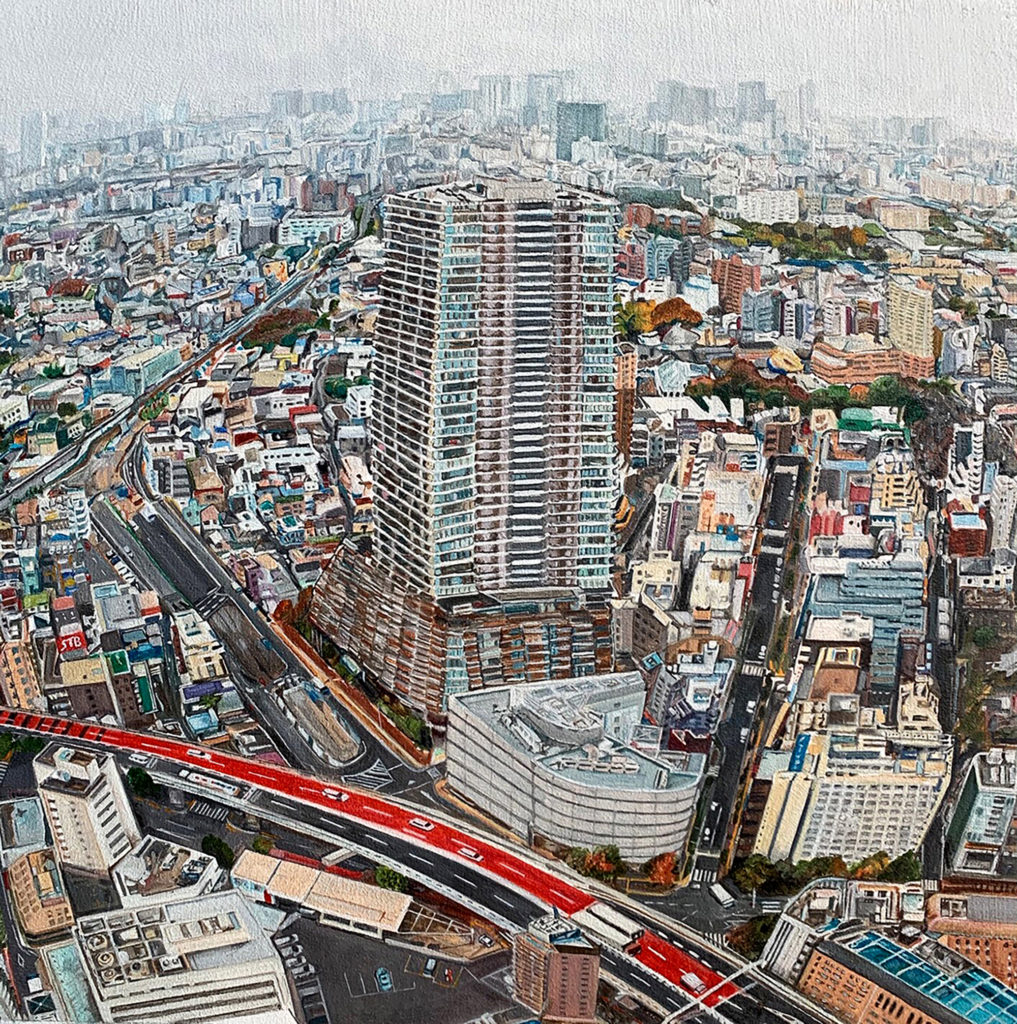
“Gojira” 16.5 x 19 inches. Oil on canvas
Tell me something about your initial approach, what was the emotional urgency that prompted you to create the first artworks?
Initially I really struggled with what to paint.
I didn’t know how to use my photo references as a tool rather than a crutch. I used to have to tell myself to just let go of being precious and try something new. I experimented with using a photo I had taken of my model and using a totally different background in order to get more artistic license. But many times getting the light correct between the background and the model doesn’t work unless it is authentic.
“Eos” 30 x 40 inches. Oil on canvas
And now what do you think is the main engine of your artistic activity, what is the biggest thrust in your artistic process?
Now it is different for me. I have confidence in my ability to improvise. I trust that I can “interpret” a photo reference rather than be imprisoned by the information the photo is giving me. I might change the color of the eyes or then elongate a foot to create interest or heighten the lightest and darkest aspects of the room to create drama. I hope to continually push that confidence. Maybe eventually my work will be wholly abstract rather than realistic.
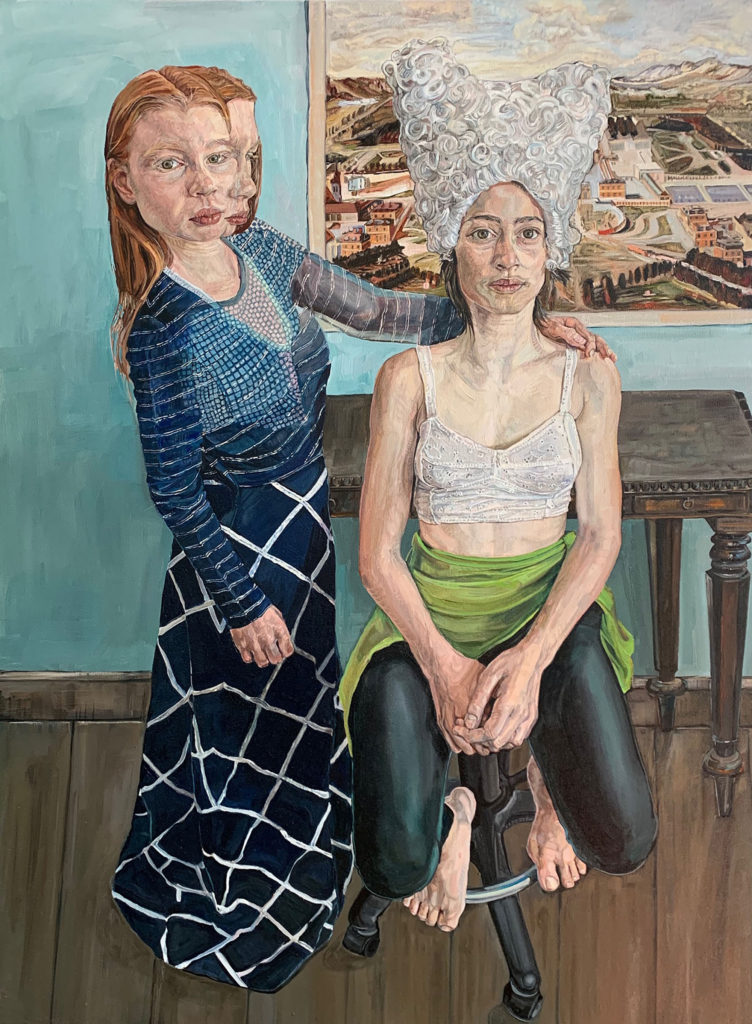
“Compersion” 30 x 40 inches. Oil on canvas
How do you organize your working week? Do you have fixed days for new ideas, others for painting process, others for promotion … or don’t you follow a pre-established schedule?
I am the worst at setting a schedule. Due to the fact that I am also an ER nurse I tend to paint on as many days as possible when I am not at the hospital. I work when my girls are at school. On the weekends when my kids are watching morning movies I might bring my easel into my living room and paint in front of the TV so that I can converse with them while I paint. Mommy guilt is real. I’m not gonna lie. It’s a real struggle for me to get enough time to paint. And I get frustrated when life takes over and distracts me from my drive to create. But my kids will always be my priority. I start thinking about the next painting when I am 75% done with the current one. I usually work one painting at a time. As for promotion I jump on opportunities when I see them and I make regular posts of my new work on Instagram.
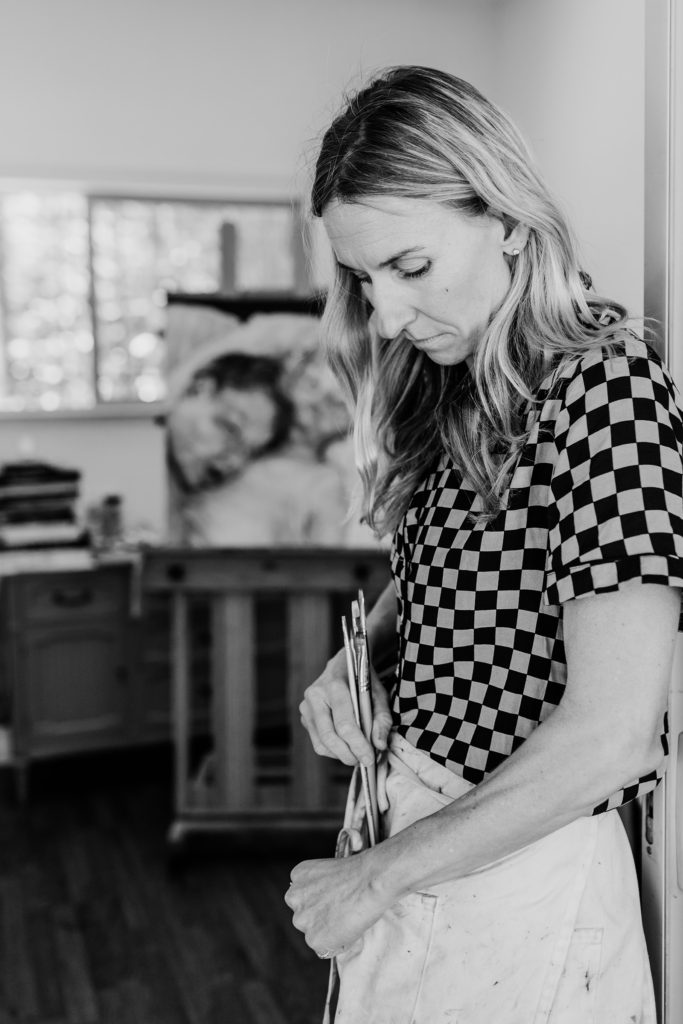
How much is hard for you to promote your work? I mean, do you have a good relationship with the social media and the promotion of your works online, or is it something you consider necessary but it doesn’t convince you at all?
I find the promotional aspect of my work kind of fun. I very much follow my gut when deciding how to promote it. Recently British Vogue approached me about paying them to feature my work. I wasn’t crazy about the idea of paying for this promotion but the fashion aesthetic and international exposure won me over. I mean it’s VOGUE. How could I say no? Social media is a mixed bag for me. I love it because I have met some of my most inspiring and incredible artist friends there. I have made sales through Instagram and it is nice to hear people’s commentary about how they experience my work. But then again, getting a lot of “likes” for your work means very little in the end. I believe there is the world of the art scene that has everything to do with specific galleries and collectors and very little to do with social media. That is the world I would be honored to be a part of.
“The Nanny” 36 x 49 inches. Oil on canvas
Let’s play with time for a minute: you’ve booked a dinner table for 4, and you can invite whomever you want from Ramses II to Billie Eilish. Tell me your DDT, Dinner Dream Team.
I can only pick three? I would take the fourth position I assume because I would want to pick each of their brilliant brains? Damn. I’d have to go with Walt Whitman, Jan Van Eyck and Jenny Saville. You would have to promise me I could speak Flemish in order to talk with JVE!
Here we go, Proust Questionnaire:
Your favorite virtue:
Honesty
Your main fault:
Capriciousness
Your idea of happiness:
Having all my family at a table set with a feast and the knowingness that we would all be together in the morning to adventure in the wilderness.
If not yourself who would you be:
I have no want of being anyone but myself. Yet, I must find myself more deeply and with a resolute commitment to be wholly me in all my imperfections. But maybe if I COULD be someone for a day it would surely have to be Jenny Saville.
How you wish to die?
It is not the how that is important to me. It is the when. This wish hinges solely on seeing my kids grow up and my art come to its full potential for this lifetime.
What is your present state of mind?
I am going through a separation from my husband of 23 years therefore my current state of mind is a mix of sadness and freedom.
Our time is running out, let’s leave ourselves with your vision for the future. Please tell me the projects (paintings/exhibitions…) you would like to achieve, and something you would finally get rid of?
Wel, I approach my future with my art as a series of connected and fated opportunities. I don’t spend a lot of time fixating on one ultimate achievement. Doing a commission for a friend is just as important to me as the MOMA. My only hope is that people recognize the depth of emotion and the practiced skill in my work. I’d like to get rid of my fear of failure because I know the lack there of will take me to bigger success when painting my pieces.
Ali Warren: Website | Instagram
 “The Tutor”. 30 x 24 inches. Oil on canvas
“The Tutor”. 30 x 24 inches. Oil on canvas